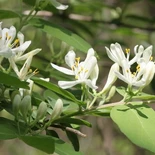Researchers have documented, in many recent studies, that the Eurasian honeysuckle (Lonicera sp.) hereafter referred to as “honeysuckle” shrubs are much more harmful than previously believed. While it has long been known that these shrubs are invasive, and obliterate native understory vegetation, including native shrubs and herbaceous plants, it has now been shown that honeysuckles are also very detrimental to birds, trees, and yes, even humans.

Amur Honeysuckle(Lonicera maackii)

Tatarian Honeysuckle(Lonicera tatarica)

Morrow's Honeysuckle(Lonicera morrowii)
Bad for birds
Let’s take a look at birds, first. Birds love the berries so you might think, as even some “experts” have contended, that Eurasian honeysuckles have at least one important redeeming quality, and perhaps we should not be removing them. But Dr. Amanda Rodewald at the School of Environment and Natural Resources at the University of Ohio has a decade of research to show otherwise. She has demonstrated that honey suckle disproportionately affects rare birds, while also being detrimental to common species.
How does this happen? She has summarized her findings in five main points:
- The presence of honeysuckle reduces both the numbers and nesting success of rare birds such as the Acadian flycatcher, which avoids dense honeysuckle thickets.
- Birds that purportedly benefit from honeysuckle are generally the more common birds that do well in a variety of developed areas. These birds have a lower conservation priority than the rare birds that may be harmed by honeysuckle.
- Rodewald, as well as researchers at the Morton Arboretum in Illinois, have found that there is more predation of the nests of cardinals and other songbirds in honeysuckle (and buckthorn) than in native shrubs.
- Honeysuckle increases the risk of cowbird parasitism, and thus reduces the nesting success of Acadian flycatchers.
- Honeysuckle reduces the success of the brightest and healthiest cardinals because they are best able to secure habitat in honeysuckles, but ultimately produce fewer offspring because of the higher predation rate.
Stunts the growth of trees
The harmful effects of honeysuckle on trees was documented by Dr. Brian C. McCarty at the Department of Environmental and Plant Biology at Ohio University and his doctoral student, Kurt M. Hartman. By taking tree cores in Ohio forests invaded by honeysuckle, they found a significant reduction in overall tree growth. Twelve nvaded forest stands were compared to four uninvaded stands. Overall tree growth was reduced by 53.1 percent in the invaded sites. Not surprisingly, the density and diversity of herbaceous plants, tree seedlings, and saplings were also significantly lower. Sadly, Hartman states, “Throughout the landscape where we conducted our study, native shrubs are a rarely encountered life form.”
Not good for you either
Honeysuckle has an adverse affect on humans, as well. Back in 2004, researchers at the Lyme Disease Research Laboratory at Maine Medical Center Research Institute found that the number of blacklegged ticks were doubled on sites with invasive shrubs like honeysuckle and Japanese barberry, (Berberis thunbergii). There were twice as many adults and nearly twice as many nymphs in plots dominated by these exotic invasives than in plots dominated by native shrubs. It is well known that Lyme disease is spread through tick bites. Because of this association, the researchers concluded that “exotic-invasive understory vegetation presented an elevated risk of human exposure to the vector tick of Lyme disease.” Similar results were documented in 2010 by researchers in Missouri. In this case, they found that yet another tick-spread disease, ehrlichiosis, is promoted by honeysuckle. White-tailed deer, (Odocoileus virginianus), primary hosts for ticks, preferred invaded honeysuckle sites in this study. In turn, this resulted in significantly higher numbers of ticks in the honeysuckle thickets, compared to sites without honeysuckle. Even worse, there were 10 times the number of nymphs infected with the disease bacterium, the ultimate cause of ehrlichiosis. The researchers concluded: “Overall, these experimental results confirm the hypothesis that deer preferentially use areas invaded by honeysuckle, increasing the abundance of ticks in those areas and increasing the resulting disease risk.”
Attacking Honeysuckle
Author’s Note: Autumn is an excellent time to attack honeysuckle and apply herbicide either through injection or stump painting. I’ve never tried the former, but purportedly it is easier. In either case, sap travels down to the roots in fall and carries the herbicide with it, making autumn the perfect time for application.

